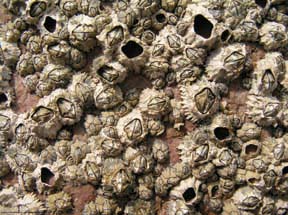Barnacles: We're Stuck With Them
By Kathy Reshetiloff

Barnacles. Throughout time, there have been many misconceptions surrounding these simple creatures. This is illustrated in the origin of the word barnacle. This word first appeared in the 13th century, used in reference to a European species of geese.
It was not known that the barnacle goose spent its summers in the Arctic. Because the bird was never observed breeding, fantastic theories accounted for its birth. At one time it was theorized that the adult barnacle goose grew from little shells attached to trees and small barnacles on driftwood by the seashore. The sun was supposed to cause the small crustaceans to grow into large birds.
The goose’s real method and place of birth were discovered but misconceptions continue. Many people, observing the cone-shaped shells of barnacles attached to piers, boats and driftwood, refer to them as mollusks. Mollusks, which include clams and snails, are soft-bodied animals enclosed in a hard calcareous shell. At first glance, a barnacle looks like a mollusk, as it is entirely enclosed in a hard shell and does not appear to have any legs.
But the barnacle is actually a crustacean, more closely related to crabs and shrimp. Crustaceans are characterized by a hard exoskeleton and jointed legs. Hidden by its external shell, a barnacle has been described as a “shrimp-like animal ... in a limestone house.”
The shell is composed of six overlapping plates with an opening at the top covered by two hard flaps. When the barnacle is submerged in water, the two flaps, acting as doors, open up. The barnacle unfolds a fan of feathery appendages. Upon closer inspection, one can see the jointed legs which make up this fan. The barnacle will wave this fan through the water to sweep tiny food particles into its “shell.”
Barnacles are hermaphroditic, each individual possessing both male and female organs. To reproduce, however, a barnacle’s eggs must be fertilized by another individual. This is accomplished by a sperm tube that protrudes from one barnacle into a neighboring one.
Fertilized eggs are nurtured in the barnacle until they hatch into tiny larvae and are released into the water during May and June. Barnacle larvae are a favorite and abundant food source for many young fish and are consumed in large numbers.
Barnacle larvae pass through two stages. The first stage is called the nauplii, a triangular form that exists for a few days before molting into the cypris, which looks like tiny transparent seeds. The cypris larvae swim about for a few days, searching for a suitable place to attach. Cypris larvae often attach to areas occupied by other barnacles of the same species. It is thought that a chemical released by older barnacles attracts the cypris larvae. The cypris attaches itself at its head by a cement secreted by its antennal glands. After its attachment, the barnacle begins to produce the calcareous plates that will encase it.
As it grows, so too will its shell. The barnacle’s shell is composed of calcium carbonate. The shell is enlarged by adding calcium carbonate along the edges of each plate, increasing the size of the inside cavity. Then, like other crustaceans, the barnacle sheds its exoskeleton, growing in size.
Barnacles adhere to piers, boats, plants, rocks and shells in the intertidal zone. This is an area that is submerged by tides and then exposed to air as the tides recede. When the barnacle is exposed to the air during low tide, the two flaps which open at the top will shut tightly. This keeps the animal inside moist until the tide rises again.
Three species of barnacle are found in the Chesapeake Bay and its tributaries. The bay barnacle Balanus improvisus, dominant in upper half of the Bay, thrives in salinity ranging from .5 to 30 parts per thousand (ppt).
The ivory barnacle Balanus eburneus, found in the lower Bay region, tolerates higher salinities, ranging from 5 to 30 ppt. It is hard to distinguish the bay barnacle from the ivory barnacle; although the ivory barnacle has wider spaces between its plates and longitudinal grooves on its top valves. The little gray barnacle Chthamalus fragilis, found only in the lower Bay, congregates in salinities ranging from 10 ppt to sea water.
Barnacles, though well protected, are susceptible to dryness, extreme cold and harsh winds. Predators include sponges, worms and bryozoans, which grow over and smother them.
Of course, anyone who owns a boat, curses these tiny creatures and the tedious and difficult task of removing them. But barnacles, whether one despises them or not, are a unique and necessary part of the Chesapeake Bay ecosystem. Back |

